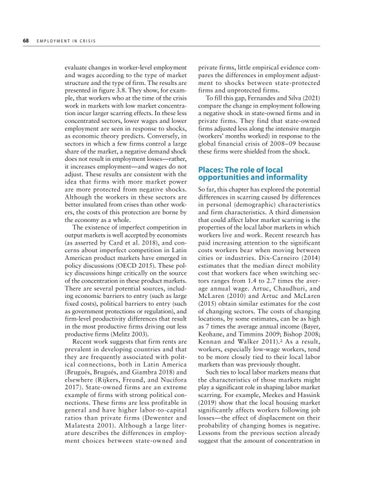68 E m p l o y m e n t
in Crisis
evaluate changes in worker-level employment and wages according to the type of market structure and the type of firm. The results are presented in figure 3.8. They show, for example, that workers who at the time of the crisis work in markets with low market concentration incur larger scarring effects. In these less concentrated sectors, lower wages and lower employment are seen in response to shocks, as economic theory predicts. Conversely, in sectors in which a few firms control a large share of the market, a negative demand shock does not result in employment losses—rather, it increases employment—and wages do not adjust. These results are consistent with the idea that firms with more market power are more protected from negative shocks. Although the workers in these sectors are better insulated from crises than other workers, the costs of this protection are borne by the economy as a whole. The existence of imperfect competition in output markets is well accepted by economists (as asserted by Card et al. 2018), and concerns about imperfect competition in Latin American product markets have emerged in policy discussions (OECD 2015). These policy discussions hinge critically on the source of the concentration in these product markets. There are several potential sources, including economic barriers to entry (such as large fixed costs), political barriers to entry (such as government protections or regulation), and firm-level productivity differences that result in the most productive firms driving out less productive firms (Melitz 2003). Recent work suggests that firm rents are prevalent in developing countries and that they are frequently associated with political connections, both in Latin America (Brugués, Brugués, and Giambra 2018) and elsewhere (Rijkers, Freund, and Nucifora 2017). State-owned firms are an extreme example of firms with strong political connections. These firms are less profitable in general and have higher labor-to-capital ratios than private firms (Dewenter and Malatesta 2001). Although a large literature describes the differences in employment choices between state-owned and
private firms, little empirical evidence compares the differences in employment adjustment to shocks between state-protected firms and unprotected firms. To fill this gap, Fernandes and Silva (2021) compare the change in employment following a negative shock in state-owned firms and in private firms. They find that state-owned firms adjusted less along the intensive margin (workers’ months worked) in response to the global financial crisis of 2008–09 because these firms were shielded from the shock.
Places: The role of local opportunities and informality So far, this chapter has explored the potential differences in scarring caused by differences in personal (demographic) characteristics and firm characteristics. A third dimension that could affect labor market scarring is the properties of the local labor markets in which workers live and work. Recent research has paid increasing attention to the significant costs workers bear when moving between cities or industries. Dix-Carneiro (2014) estimates that the median direct mobility cost that workers face when switching sectors ranges from 1.4 to 2.7 times the average annual wage. Artuc, Chaudhuri, and McLaren (2010) and Artuc and McLaren (2015) obtain similar estimates for the cost of changing sectors. The costs of changing locations, by some estimates, can be as high as 7 times the average annual income (Bayer, Keohane, and Timmins 2009; Bishop 2008; Kennan and Walker 2011). 3 As a result, workers, especially low-wage workers, tend to be more closely tied to their local labor markets than was previously thought. Such ties to local labor markets means that the characteristics of those markets might play a significant role in shaping labor market scarring. For example, Meekes and Hassink (2019) show that the local housing market significantly affects workers following job losses—the effect of displacement on their probability of changing homes is negative. Lessons from the previous section already suggest that the amount of concentration in

